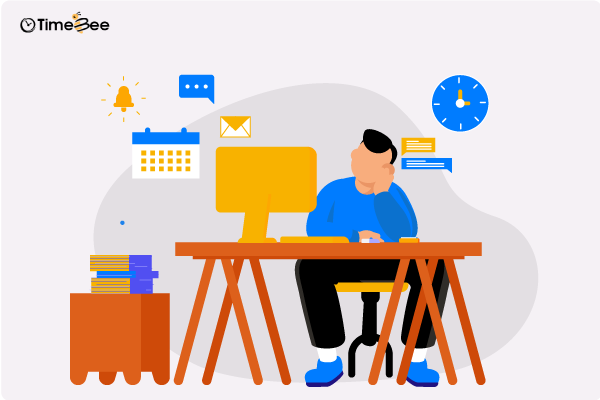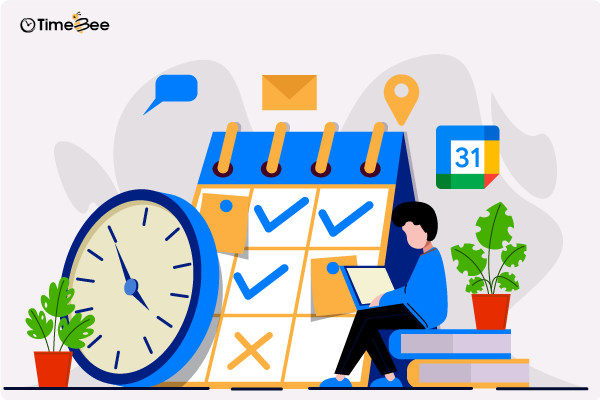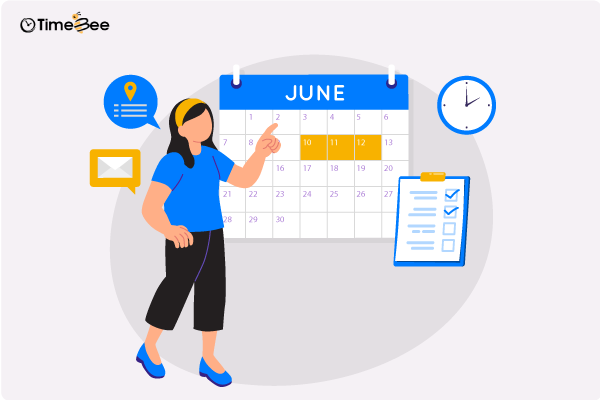Content
Content
Working long hours won’t get you where you want to be. Being productive and precise will surely do.
After the pandemic, while employers are still figuring out the new norm, a recent debate has surfaced: Employee productivity vs hours worked.
So, if you are also wondering whether longer hours mean better productivity or vice versa, you’ve landed on the right page.
We will discuss key differences between productivity and hours worked, what factors affect productivity, best practices to balance time and productivity, how this helps, and a secret solution to make your team more productive.
But before we discuss the details, let’s consider this debate from a historical perspective.
Employee Productivity vs. Hours Worked: Understanding The Key Differences
Output separates productivity from working hours. Productivity is the amount of output an employee produces in a given timeframe. On the contrary, hours worked is the time they spend working.
Productivity vs Worked Hours: A Historical Overview
Before the 1940s, people worked more than 70 hours a week. Then, a new law in America capped full-time working hours at 40 to increase productivity. This was the first time hours were reduced to increase productivity.
Even today, most corporations and other industries worldwide work 8 to 9 hour shifts. However, debate about the workings of this phenomenon started in 2021, when around 47 million Americans quit their jobs.
One of the main reasons for this debate is the increasing value of time and work-life balance. Let’s see what modern studies suggest about this relationship between hours worked and productivity.
What do Modern Studies Suggest?
In 2018, Perpetual Guardian, a trust management company based in New Zealand, experimented with a four-day workweek with 32 hours.
Even though employees worked fewer hours, they were able to produce consistent output and show significant improvement.
The employees were more motivated, happier, and more satisfied than ever. Their work-life balance was restored, and they became more efficient and productive.
Another study was conducted in Iceland. From 2015 to 2019, the government lowered the working hours of government officials from 40 to 35 per week. Around 2,500 city and government employees participated in Reykjavik.
As a result, burnout and stress decreased, employees reported better work-life balance, and productivity increased. The study was so successful that the trade unions negotiated a permanent reduction of working hours. And now, roughly 86% of the population implements it.
This boils down to the question: how much time should your employees spend weekly?
According to studies, the average human’s productivity level lasts 2-3 hours and a maximum of 6 hours. If you do a mentally draining job, working at most 3 hours is suggested. Moreover, working shifts longer than 8 hours decrease productivity and efficiency.
Based on the findings, 30-40 hours a week is a good time to work productively.
Not only are long hours the enemy of productivity, but other factors also affect an employee’s efficiency. Let’s examine them.
Factors That Affect Productivity
Many estimate productivity with working hours, but several other external variables can affect a person’s output and decrease productivity. Here are some of the most common factors.
Lack of Communication
Effective communication is the secret to successful project completion. A lack of communication in the workplace can lead to many disasters, such as misunderstandings, work inaccuracies, and delays.
Due to improper instructions and poor communication, employees might need more information for efficient and effective work. This will result in low morale, decreased productivity, and longer work hours than anticipated.
Poor Time Management
Poor time management and focusing on unnecessary tasks lead to missed deadlines and inefficient outputs.
When work is not completed until the last minute, employees rush things, which causes grave errors. This results in inadequate work and decreased productivity.
Lack of Technology
Employees will likely show unproductive results if a company is not using suitable technology to enhance and optimize operations.
One of the main reasons for this is tasks that can be automated will require most of an employee’s time, leaving little to no time for actual work.
Workplace Culture
A happy and satisfactory workplace culture is a need in this era. Regardless of everything being above average, employees must be satisfied where they work to produce productive outputs.
A hostile workplace culture will lead to low morale, high turnover, and inefficiency.
Inflexibility
After Covid-19, everyone wants flexibility. Inflexible work hours and rigid rules can demotivate employees. They may feel stifled and unsupported.
This will lead to decreased productivity, and employees will do work for the sake of completing it rather than enjoying it and working precisely.
10 Best Practices To Make Your Employees More Productive In Fewer Hours
After all the proven data we discussed, the debate about employee productivity vs. hours worked is imperative.
Here are the top 10 best practices for balancing productivity with working hours.
Set SMART Goals
SMART is an acronym for Specific, Measurable, Attainable, Relevant, and Timebound. These goals are different from the usual vague goals.
They help an organization meet deadlines faster, ensure quality and quantity, optimize operations, and overall efficient work.
Since you give the teams specific goals, they always focus on the task. Measurability and attainability factors keep them motivated and help them avoid distractions.
Better incentives make tasks relevant, and time-bounding creates an urgency to accomplish projects within the deadline.
SMART goals will help your employees be more productive and efficient.
Flexible Work Arrangements
Inflexibility is a productivity killer. After the pandemic, flexible work arrangements have become trendier.
Flexible work options, for example, flexible schedules, job-sharing, telecommuting, hybrid work, etc., will lead to improved productivity, better job satisfaction, reduced stress, and better work-life balance.
Allowing employees to work in a way that suits them will keep them motivated and productive. autonomy will hold them accountable for their work, resulting in quality outputs.
Ultimately, flexible working arrangements will align employees’ demands with their work, while organizations will be able to retain top talent, eventually benefitting both employee and employer.
Minimize Meetings
Minimizing your regular meetings will ensure more work and less talk. Streamlining your daily tasks via management tools and reducing unnecessary meetings will free up your team’s valuable time and allow them to do deep work.
It doesn’t mean there should be no meetings. Instead, implement concise, purpose-driven meetings that curtail disruptions and foster uninterrupted workflow.
These goal-oriented meetings will also help with effective and efficient communication, swift decision-making, and problem-solving.
The idea of less is more with meetings will boost employee productivity, give them time for efficient project completion, and yield tangible results without stressing or impacting their energy levels.
Provide Tools and Resources
Because of the difference in adequate tools and resources, Egyptians took 15 to 30 years to build pyramids, while it only took 22 months to erect the world’s tallest building, the Eiffel Tower.
Egyptians didn’t have the technology, but French engineers were efficient and productive because they had the right tools and resources.
Similarly, to increase your team’s productivity, provide them with cutting-edge software and hardware to help them complete tasks without burning out.
Updated tools and technology will expedite processes, reduce manual work, foster innovation, and amplify overall productivity.
Encourage Breaks
We often consider employees unproductive when they take short breaks between work. However, studies quote the opposite.
Researchers at the University of Toronto found taking short breaks prevents mental fatigue and fosters sustained productivity throughout the workday.
Another group of researchers from Drexel University suggested that participants who took short breaks maintained a consistent level of focus and productivity compared to those who didn’t.
Allowing breaks between work will construct a valuable work culture, reduce stress levels, improve job satisfaction, eliminate burnout, and boost employee productivity. Prioritizing your employee welfare will lead to prioritizing your organizational goals.
Delegate Effectively
Delegating tasks effectively will give your employees a clear road map, help them focus on the work, and avoid unnecessary distractions.
As an employer, you know your employees better. If you want productive and efficient work, start strategically delegating tasks to employees according to their talent and skills.
This will not only keep them motivated but also empower them to take responsibility.
This trusting relationship will strengthen their commitment to work and instill a sense of leadership. Moreover, it will maximize their confidence and encourage professional growth, ultimately elevating the team’s productivity.
Eliminate Distractions
Eliminating distractions = Amplified focus and productivity. If you want quality work with quantity, minimize distractions and encourage a focused work environment.
Implement the following policies or strategies to ensure no distractions are left for your team.
- Eliminate mobile phone use during work.
- Discourage multi-tasking
- Install productivity software with distraction alerts on your team’s systems.
- Allow short break intervals between work.
- Improve time management by applying time blocking, time batching, or other techniques.
- Block unproductive sites and apps.
Once you mitigate distractions, you can elevate efficiency and channel your team’s undivided attention into deep work.
Encourage Skill Development
If your employees are not developing their skills, they’ll not remain compatible with drastic changes.
This is why investing in good training programs, workshops, and other educational resources is essential.
Encourage your team to continue their education and increase their skills by providing lucrative incentives. Continuous learning will sharpen their expertise, help them make better decisions, and be able to solve problems effectively.
Nurturing a learning culture will inspire innovation, career growth, improved operations, and enhanced productivity. Champion skill enhancement to unlock your team’s potential.
Prioritize Tasks
Start prioritizing to do tasks efficiently. There are multiple task management techniques you can use to ensure your team meets the deadline without any hassles.
One of them is Eisenhower’s urgent matrix. In this, you categorize tasks into four groups: Urgent and important, important but not urgent, urgent but not important, and not urgent nor important. Another technique is the ABC method, where Task A is the most important task, B is an important task but not time-sensitive, and C is neither urgent nor particularly important.
By strategically prioritizing your tasks, you will empower your team to do more in less time and with their productivity at an optimum level.
Recognize and Reward
Everyone works not just for money but for acknowledgment as well.
In 2000, corporations like Google changed the dynamics of the corporate world by providing benefits to their employees, like free meals, nap pods, etc. It showed significant improvement.
When an employer offers recognition and rewards, it instills accountability and a sense of accomplishment in an employee. Initiatives like these also strengthen employee engagement, loyalty, and commitment to meet deadlines and achieve goals.
These rewards don’t have to be big; even small positive reinforcements bring great results.
How Can You Increase Your Team’s Productivity With TimeBee’s Employee Monitoring Tool?
Don’t get intimidated by a long list of best practices to boost your employees’ productivity. If you’re smart, you can implement almost all these practices simultaneously.
Use TimeBee. It is a productivity and time-tracking app that helps businesses manage projects, budgets, and workforce. Multiple features also take your productivity game to the next level.
Here is a short overview of how TimeBee will empower your teams to be more productive and efficient.
Clock Your Productive Hours with Automatic Time Tracker
TimeBee tracks your online and offline time to keep a record and provide reports. These reports have data on your productive and unproductive hours, which helps you plan better and evaluate your employees’ time spent.
Create and Track Projects and Tasks
Setting specific, time-bound goals is easier. Prioritize your projects, add them to TimeBee, schedule your team by delegating tasks under each project, and let the tracker track your time working on them.
Minimize Distractions with Distraction Alert Pop-up
Easily set up distraction alert pop-ups at intervals of your choice. The app will pop up an alert whenever your employee’s screen is idle for a set amount of time. If your employee is on break, it’ll stop the timer.
Monitor and Rate Web and App Usage.
In TimeBee, the web and app are rated according to global standards. However, you can customize sites and apps to be productive or unproductive according to your company’s policies. This will help you block unproductive sites and be more productive.
Capture Screenshots for Screen Monitoring
It’s difficult to manage remote and hybrid teams. However, TimeBee’s screenshot feature will make the task more straightforward and manageable. Set screenshot intervals and let the app capture screens. Check the captures to get an idea of your team’s work without bothering them repeatedly.
Conclusion
Studies and research suggest shortening working hours will increase employee productivity. However, you’ll have to create a productive work environment and culture to ensure they are fruitful.
We have also provided a single solution to help you implement most of the best practices discussed above regarding balancing productivity and work hours.
We hope you take your team to the next level and accomplish all your goals.
FAQs
Does working fewer hours increase productivity?
Many studies by companies, including Microsoft Japan and Perpetual Guardian, suggest fewer working hours lead to improved productivity and efficiency. For example, When Perpetual Guardian shortened their work week to 4 days, employees were more focused and less likely to make errors.
How many productive hours in a day?
According to research, the average time humans spend being productive is approximately 3-4 hours if they have mentally draining jobs. However, many studies have also capped metrics at a maximum of 6 hours of deep work.
What is the average productivity of an employee?
According to statistics compiled from nearly 2000 employees, they don’t feel productive for the whole 8-hour working day. The study found that the average employee remains productive only 61% of the time. In contrast, CoSo Cloud’s Remote Collaborative Worker Survey found that 77% of employees are more productive in remote work.
Similar Reading



